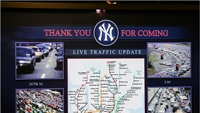Cisco makes its TelePresence felt for interactive fan experience

Computer network company Cisco is expanding into sports entertainment with what it calls “TelePresence” systems, which are now being installed in venues and allow sports fans to have face-to-face virtual HD conversations with sports stars. This evolution of video teleconferencing allows fans to actually speak with players.
Cisco’s clients now include the New York Yankees, Dallas Cowboys, Kansas City Royals, Toronto Blue Jays, Arizona Diamondbacks, Miami Dolphins and Arizona Cardinals. The NBA used Cisco’s technology to create an immersive “in-person” experience that brought NBA players and legends closer to fans at the All-Star Game in Phoenix last month.
In addition, ESPN broadcast exclusive NBA All-Star Weekend reports on the network’s news and information shows, such as “SportsCenter,” directly from the Cisco TelePresence system in Phoenix back to ESPN’s studio in Bristol, CT. With the implementation of TelePresence in ESPN broadcast operations, the sports network was able to deliver a higher level of interactive sports broadcasting for major events.
“By deploying Cisco TelePresence directly on the NBA Jam Session show floor, we bridged the gap between athletes and fans, giving basketball enthusiasts a virtual pass to the arena with a unique ability to interact with players in new ways that were not possible at previous marquee sporting events,” said Cisco’s Alan Cohen, VP of enterprise marketing.
Cisco wired both the new Yankee and Cowboys stadiums, giving the host teams interactive showplaces for the next-generation fan experience. The infrastructure is in place at TD Banknorth Garden in Boston, which at press time was close to partnering with Cisco.
Executives at TD Banknorth Garden would like Cisco’s StadiumVision installed when the 2009-10 NHL season starts. The video display application would network the arena’s 600 HDTV monitors and enable customized applications for its in-house digital signage network.
Walking through concourses after the fourth quarter, Celtics fans, for example, might see arrows pointing to the nearest exits and real-time traffic updates for Storrow Drive — and that would be only Phase 1.
The professional video industry's #1 source for news, trends and product and tech information. Sign up below.
Sports leagues and teams have been observing fan conduct from their Web site hits, blogs and video clips. They’ve also borrowed from Twitter, Facebook and TiVo. They’ve recognized that fans want greater access to players, more efficiency inside arenas and increased convenience wherever and however they consume sports.
Mark Cuban, owner of the Dallas Mavericks, told the “Boston Globe” that we’ll soon see a video display that stretches the 94ft of the basketball court. He also envisions digital delivery of sound that can be customized by an arena’s seating area.
Cisco created its vision of the future sports stadium at its headquarters in San Jose, CA, where it hosts high-tech ticket kiosks, HD monitors promoting a fictional Kids’ Day and a concession stand requiring only a card swipe.
And, of course, there’s the luxury suite. One can touch a specially designed phone to buy a team jersey, order hot dogs and change the camera angles displayed on a set of nearby TV screens. One screen shows inside the dugout, and another shows the view behind home plate.
